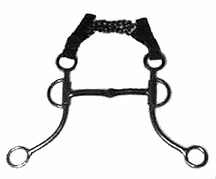Dudley's Story, continued...
Dudley, like Sandia, was clearly not vicious. What was his
problem? The immediate issue was that as soon as I would halter
him, Dudley would bash me with his head. I'd holler and yell
and hit back. Dudley would sober up and behave. Then the next
day he'd bash me again.
Debbie came to the rescue. The first time Dudley tried to
whack her with his head, she fluttered her hand at his eye. He
backed off and acted real polite. This worked for me, too. After
a few hand flutters, Dudley gave up head bashing for good.
I brought out Dr. Hanosh to see if any of his behavior problems
had a physiological cause. The vet pronounced him sound and healthy.
Next came hoof care. It clearly had been a while since Dudley
had seen a farrier. His hooves splayed out. Chunks had cracked
off. However, Philip Johnson agreed with Hanosh that Dudley was
sound. With just one trimming, he got Dudley's feet into good
shape for riding.
Philip pointed out the fact that Dudley's withers had a patch
of white hair on each side. Dudley's problem was that he had
"mutton withers," meaning that they were wide and round.
Most horses have narrow withers. That's what the average saddle
is desigend to fit. On a horse with mutton withers, an average
saddle is painful. In his case, a saddle had inflicted injuries
so bad that they left permanent scars. That's why Dudley had
often bucked people off. It was self-defense.
Philip helped us come up with a saddle and padding arrangement
that made Dudley comfortable.
|
Marcie gave me Dudley's old bridle. She said the guy
who sold it to her had claimed its bit was gentle.
Debbie took one look at the bit and declared that it was a
wreck waiting to happen. True, it looked kind of like a full
cheek snaffle, the bit that worked so well with Coquetta. However,
the reins attached to long shanks, and a chain ran under the
chin. "This bit works on a horse's jaw like a nutcracker,"
Debbie said. "It can be excruciatingly painful." Probably
painful enough to drive a horse berserk if someone pulled the
reins too hard. She recommended a simple snaffle. |
 Dudley's old
bit. Dudley's old
bit.
|
I was the first to try to ride him. Within seconds, Dudley
tried to toss the reins over his head. Western riders hold the
reins slack most of the time. That makes it easy for a horse
to toss them. If both reins wind up on the same side of a horse's
neck, the rider can't do anything but turn him in circles. After
a few dozen head tosses, I got off him. Time to think it over.
The western solution is a tiedown. This is a rope or length
of leather that ties a nosepiece on a bridle to a breast piece.
It holds the horse's head down so he can't toss the reins. The
English solution is a martingale. It runs the reins through two
loops on lines attached to the breast piece. A martingale is
less restrictive than a tiedown and safer. If a horse trips,
it is less likely to lose its balance and fall.
I distrusted tiedowns and didn't have a martingale. I solved
the problem by riding him while holding the reins English style,
with a mild snaffle bit and slight tension on the reins, while
holding them low . That way he couldn't toss the reins. Within
a few days Dudley quit trying to toss them. Now we could rein
him Western style again.
The most important thing was that Dudley never once tried
to buck any of us off. Now that he had comfortable tack, he had
no motivation to hurt anyone.
More --->>

